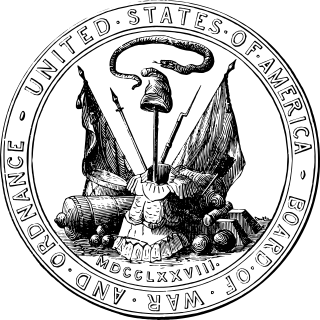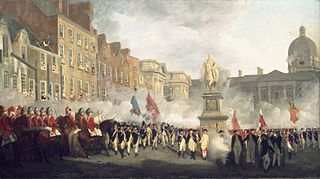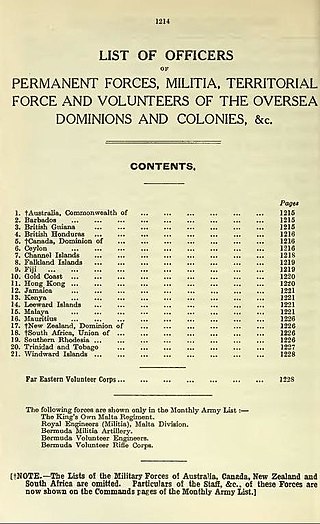
The Continental Army was the army of the United Colonies representing the Thirteen Colonies and later the United States during the American Revolutionary War. It was formed on June 14, 1775, by a resolution passed by the Second Continental Congress, meeting in Philadelphia after the war's outbreak. The Continental Army was created to coordinate military efforts of the colonies in the war against the British, who sought to maintain control over the American colonies. General George Washington was appointed commander-in-chief of the Continental Army and maintained this position throughout the war.

The British Legion was an elite British provincial regiment established during the American Revolutionary War, composed of Loyalist American troops, organized as infantry and cavalry, plus a detachment from the 16th Light Dragoons. The unit was commonly known as Tarleton's Legion, after the British officer who led it on campaign, Lieutenant Colonel Banastre Tarleton. It was a unit the size of a regiment, consisting of artillery, cavalry, and light infantry, and able to operate independently.
The 79th Regiment of Foot (Royal Liverpool Volunteers) was an infantry regiment of the British Army, also known as the Liverpool Blues, which served in the Americas during the American War of Independence.

The Battle of Springfield was fought during the American Revolutionary War on June 23, 1780, in Union County, New Jersey. After the Battle of Connecticut Farms, on June 7, 1780, had foiled Lieutenant General Wilhelm, Baron von Knyphausen's expedition to attack General George Washington's army at Morristown, New Jersey, Knyphausen and Lieutenant General Sir Henry Clinton, British commander-in-chief in North America, decided upon a second attempt. Although the British were initially able to advance, they were ultimately forced to withdraw in the face of newly arriving rebel forces, resulting in a Continental victory. The battle effectively ended British ambitions in New Jersey.

The Volunteers were local militias raised by local initiative in Ireland in 1778. Their original purpose was to guard against invasion and to preserve law and order at a time when British soldiers were withdrawn from Ireland to fight abroad during the American Revolutionary War and the government failed to organise its own militia. Taking advantage of Britain's preoccupation with its rebelling American colonies, the Volunteers were able to pressure Westminster into conceding legislative independence to the Dublin parliament. Members of the Belfast 1st Volunteer Company laid the foundations for the establishment of the United Irishmen organisation. The majority of Volunteer members however were inclined towards the yeomanry, which fought and helped defeat the United Irishmen in the Irish rebellion of 1798.

The New Hampshire Line was a formation in the Continental Army. The term "New Hampshire Line" referred to the quota of numbered infantry regiments assigned to New Hampshire at various times by the Continental Congress. These, along with similar contingents from the other twelve states, formed the Continental Line. For the promotion of senior officials, this concept is particularly important. Officers of the Continental Army below the rank of brigadier general were ordinarily ineligible for promotion except in the line of their own state.

The Loyal American Regiment was a British Provincial regiment raised in 1777 for Loyalist service during the American Revolutionary War. The regiment fought in many engagements throughout the war and the men were among the thousands of loyalists who settled in Nova Scotia, after the regiment disbanded in 1783.
The Battle of Mobley's Meeting House was an engagement that occurred during the American Revolutionary War in the Mobley Settlement, Fairfield County, South Carolina during the southern campaign of Lord Cornwallis.

Until Australia became a Federation in 1901, each of the six colonies was responsible for its own defence. From 1788 until 1870 this was done with British regular forces. In all, 24 British infantry regiments served in the Australian colonies. Each of the Australian colonies gained responsible government between 1855 and 1890, and while the Colonial Office in London retained control of some affairs, and the colonies were still firmly within the British Empire, the Governors of the Australian colonies were required to raise their own colonial militias. To do this, the colonial Governors had the authority from the British crown to raise military and naval forces. Initially these were militias in support of British regulars, but British military support for the colonies ended in 1870, and the colonies assumed their own defence. The separate colonies maintained control over their respective militia forces and navies until 1 March 1901, when the colonial forces were all amalgamated into the Commonwealth Forces following the creation of the Commonwealth of Australia. Colonial forces, including home raised units, saw action in many of the conflicts of the British Empire during the 19th century. Members from British regiments stationed in Australia saw action in India, Afghanistan, the New Zealand Wars, the Sudan conflict, and the Boer War in South Africa.

Brant's Volunteers, also known as Joseph Brant's Volunteers, were an irregular unit of Loyalist and Indigenous volunteers raised during the American Revolutionary War by Mohawk war leader, Joseph Brant. Brant's Volunteers fought on the side of the British on the frontier of New York and in the Ohio Country. As associators they were not provided uniforms, weapons, provisions, or pay by the British government, and survived by foraging and plundering.
The Volunteers of Ireland, also known as the 2nd American Regiment and the 105th Regiment of Foot, was a British Provincial military unit, raised for Loyalist service, during the American Revolutionary War, which was later added to the British regular army. The Volunteers of Ireland should not be confused with the contemporaneous Irish Volunteers an autonomous militia that supported the Irish Patriot Party, in the 1770s and 1780s.
The New York Volunteers, also known as the New York Companies and 1st Dutchess County Company, was a British Loyalist Provincial regiment, which served with the British Army, during American Revolutionary War. Eventually, the New York Volunteers became the 3rd American Regiment, after being place on American establishment.

The American Volunteers were a British Loyalist unit during the American Revolutionary War.
The Battle of Monck's Corner was fought on April 14, 1780, outside the city of Charleston, South Carolina, which was under siege by British forces under the command of General Sir Henry Clinton in the American Revolutionary War. The British Legion, under the command of Lieutenant Colonel Banastre Tarleton, surprised an American force stationed at Monck's Corner, and drove them away. The action cut off an avenue of escape for Benjamin Lincoln's besieged army. Aside from the British Legion, and the 33rd Foot and 64th Foot led by Lt. Col. James Webster, the force included Loyalists, the American Volunteers, led by Maj. Patrick Ferguson.

The British Colonial Auxiliary Forces were the various military forces of Britain's colonial empire which were not considered part of the British Army proper.
The Irish Patriot Party was the name of a number of different political groupings in Ireland throughout the 18th century. They were primarily supportive of Whig concepts of personal liberty combined with an Irish identity that rejected full independence, but advocated strong self-government within the British Empire.

Associators were members of 17th- and 18th-century volunteer military associations in the British American thirteen colonies and British Colony of Canada. These were more commonly known as Maryland Protestant, Pennsylvania, and American Patriot and British Loyalist colonial militias. But unlike militias, the associator military volunteers were exempt from regular mandatory military service. Other names used to describe associators were "Associations", "Associated", "Refugees", "Volunteers", and "Partisans".
The Royal Nova Scotia Volunteer Regiment, also known as the Loyal Regiment of Nova Scotia Volunteers and Loyal Nova Scotia Volunteers, from 1775-1780, the Royal Regiment of Nova Scotia Volunteers, from 1780-1783, and the Royal Nova Scotia Volunteer Regiment and Nova Scotia Volunteers, was a British Loyalist provincial battalion, of infantry, raised in 1775, to defend British interests, in the colony of Nova Scotia. The unit was commanded by Col. Francis Legge, until replaced by Col. John Parr in 1782. The Royal NS Volunteers never saw combat, but did play an important role in the defense of the colony of Nova Scotia, in the later years, of the American Revolution.
The 95th Regiment of Foot (Reid's) was an infantry regiment of the British Army.










